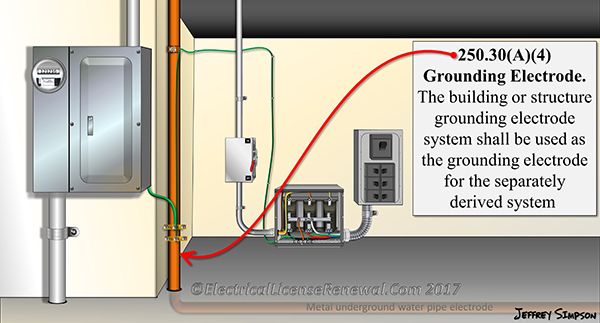250.30(A)(4)&(5) Grounding Separately Derived Alternating-Current Systems.

Code Change Summary: Proper methods for grounding a separately derived AC system have been revised.
For many code cycles, a separately derived system such as most transformers, was required to be connected to a grounding electrode that was as near as practicable to the grounding electrode conductor connection to the system. As well, the actual grounding electrode itself was required to be either a metal water pipe electrode or a structural metal grounding electrode unless neither of the two were available.
In the 2017 NEC®, much of this code language in 250.30(A)(4) was deleted and simplified. Now, the building or structure grounding electrode system shall be used as the grounding electrode for the separately derived system even if the building or structure grounding electrode system is nowhere near the separately derived system.
As well, in the 2017 NEC®, section 250.30(A)(5) now specifically mentions the methods in 250.68(C)(1) and (2) as acceptable ways to interconnect the grounded conductor from the separately derived system to the building or structure grounding electrode.
Section 250.68(C)(1) and (2) allows the first 5 feet of an emerging metal underground water pipe that qualifies as a grounding electrode, or structural building steel to be used to extend or interconnect the connection to an electrode (see image).
Below is a preview of Article 250. See the actual NEC® text at NFPA.ORG for the complete code section. Once there, click on their link to free access to the 2017 NEC® edition of NFPA 70.
2014 Code Language:
250.30(A)
(4) Grounding Electrode. The grounding electrode shall be as near as practicable to, and preferably in the same area as, the grounding electrode conductor connection to the system. The grounding electrode shall be the nearest of one of the following:
(1) Metal water pipe grounding electrode as specified in 250.52(A)(1)
(2) Structural metal grounding electrode as specified in 250.52(A)(2)
Exception No. 1: Any of the other electrodes identified in 250.52(A) shall be used if the electrodes specified by 250.30(A)(4) are not available.
Exception No. 2 to (1) and (2): If a separately derived system originates in listed equipment suitable for use as service equipment, the grounding electrode used for the service or feeder equipment shall be permitted as the grounding electrode for the separately derived system.
(5) Grounding Electrode Conductor, Single Separately Derived System. A grounding electrode conductor for a single separately derived system shall be sized in accordance with 250.66 for the derived ungrounded conductors. It shall be used to connect the grounded conductor of the derived system to the grounding electrode as specified in 250.30(A)(4). This connection shall be made at the same point on the separately derived system where the system bonding jumper is connected.
2017 Code Language:
250.30(A)
(4) Grounding Electrode. The building or structure grounding electrode system shall be used as the grounding electrode for the separately derived system. If located outdoors, the grounding electrode shall be in accordance with 250.30(C).
Exception: If a separately derived system originates in equipment that is listed and identified as suitable for use as service equipment, the grounding electrode used for the service or feeder equipment shall be permitted to be used as the grounding electrode for the separately derived system.
(5) Grounding Electrode Conductor, Single Separately Derived System. A grounding electrode conductor for a single separately derived system shall be sized in accordance with 250.66 for the derived ungrounded conductors. It shall be used to connect the grounded conductor of the derived system to the grounding electrode in accordance with 250.30(A)(4), or as permitted in 250.68(C)(1) and (2). This connection shall be made at the same point on the separately derived system where the system bonding jumper is connected.